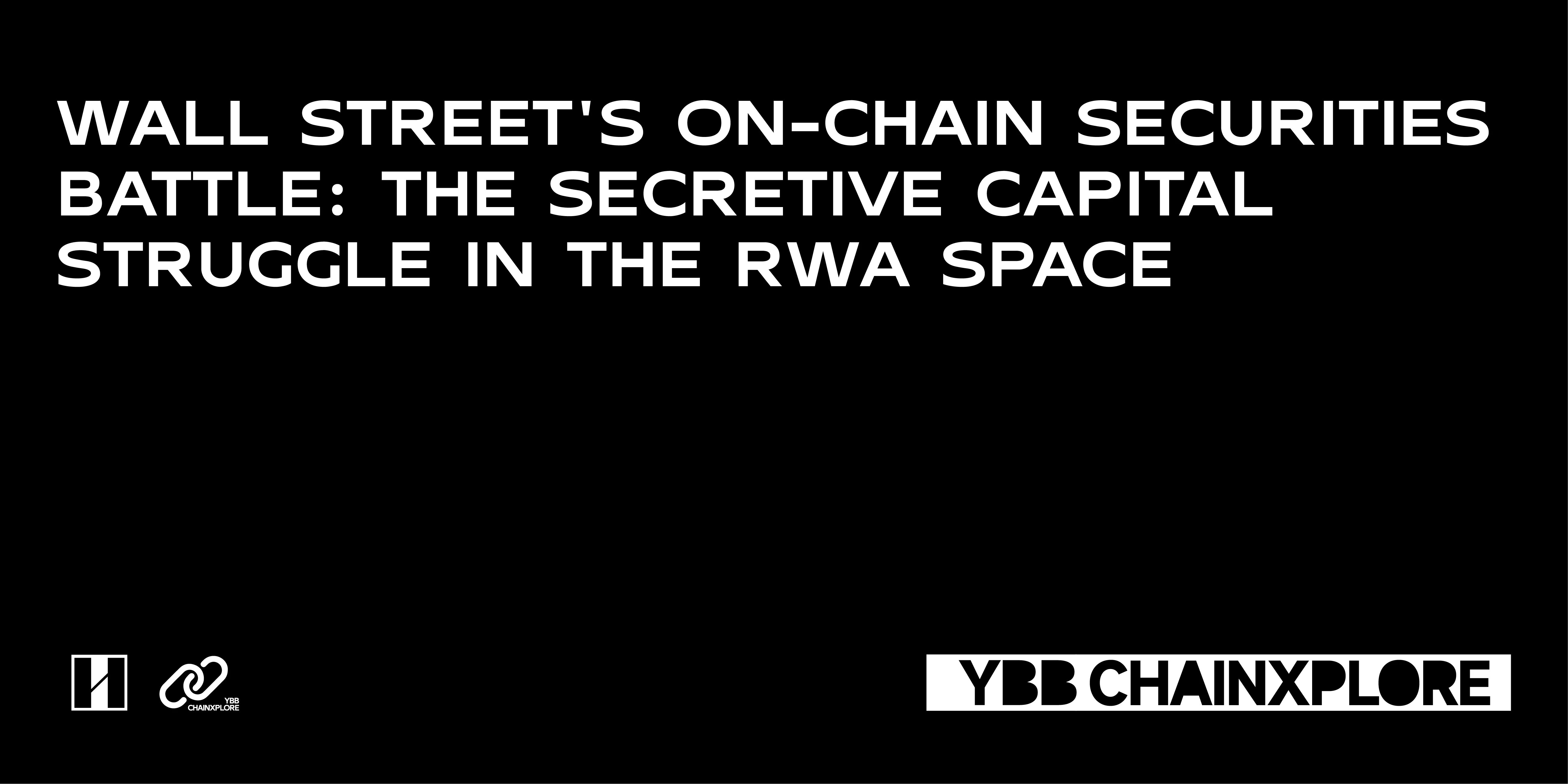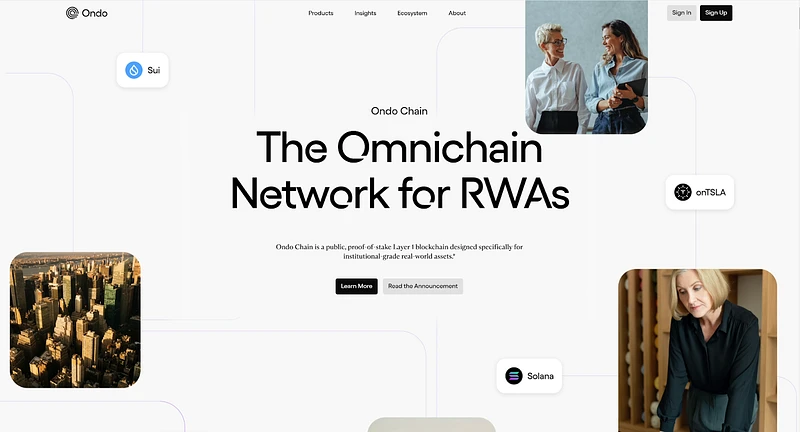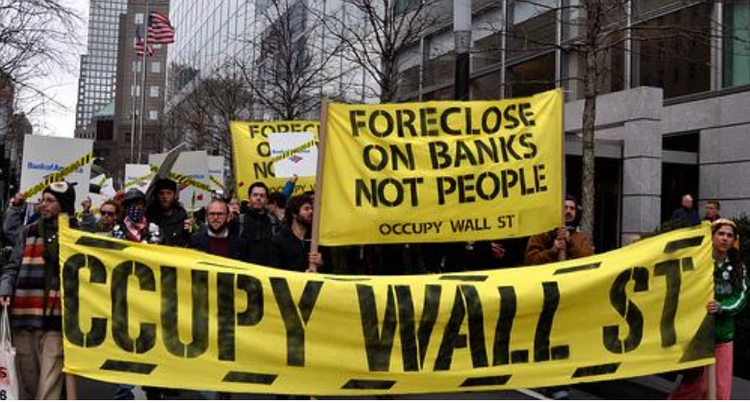Original author: YBB Capital Researcher Ac-Core

1. Introduction: Can RWA become the next watershed in the market?
With the launch of the Bitcoin spot ETF, the crypto space is reaching a new turning point. The policy trends during the Trump administration laid the foundation for this field, and now the entry of traditional financial giants such as BlackRock has further promoted the development of the RWA (real world asset) track. More and more financial institutions are beginning to explore how to achieve on-chain transactions and management of traditional assets such as stocks and bonds through blockchain technology. This trend is reshaping the financial market landscape.
The recent launch of Ondo Global Markets and Ondo Chain by Ondo Finance marks that the RWA track is gradually moving towards the mainstream. This change has also triggered a new round of gaming on Wall Street, quietly changing the rules of the game in the crypto market and traditional finance.
2. Differences and commonalities of RWA track projects

Image source: Ondo official website
2.1 Ondo Finance, a representative project of BlackRock
Ondo Finance has been making frequent moves recently. On February 5, they launched the Ondo Global Markets platform, which mainly provides blockchain access services for stocks, bonds and ETFs. Immediately afterwards, Ondo Finance announced their new Layer 1 public chain Ondo Chain, with the goal of building a more powerful financial infrastructure and promoting the tokenization of RWA.
Ondo Chain is the infrastructure of Ondo Global Markets (Ondo GM), focusing on the integration of RWA tokenization and blockchain. Ondo Chain supports global investors to obtain on-chain access to US listed securities (such as stocks, bonds, ETFs) through the blockchain platform, breaking geographical restrictions and providing 24/7 uninterrupted trading services.
Ondo Chain has launched a solution to embed institutional-level compliance into the public chain architecture. Through innovative means such as the licensed verification node mechanism and native cross-chain protocol, it attempts to overcome the pain points of existing RWA on-chain in terms of technology and system. Ondo Chain uses traditional financial assets as collateral to ensure network security and interoperate with traditional clearing systems, further opening up on-chain and off-chain liquidity.
2.2 Ondo Finance’s competitiveness and limitations among projects in the same field
This is related to its unique architectural design and powerful institutional resources, and also reflects the power and interest game between blockchain and traditional finance.
Competitiveness
By collaborating with top financial institutions such as BlackRock, we have built a blockchain financial infrastructure that can support the large-scale tokenization of real-world assets, ensuring a balance between compliance and decentralization.
Tokenization and free transfer of RWA: By pairing assets such as stocks, bonds, ETFs with tokens 1:1, investors can freely transfer these tokenized assets outside the United States and integrate them with DeFi to participate in financial activities such as lending and earning.
Combination of openness and compliance: Ondo Chain combines the openness of public blockchains with the compliance of permissioned chains. Validators are audited by permission to ensure compliance, while any developer and user can issue tokens and develop applications on the chain to ensure innovation vitality.
Institutional participation and ecosystem construction: Ondo Chain’s design advisory team includes financial institutions such as Franklin Templeton, Wellington Management, and WisdomTree, which has promoted its institutional-level applications in the fields of TradFi and DeFi.
Oracle mechanism and data security: The built-in oracle system ensures the accuracy and real-time performance of on-chain data and reduces the risk of data manipulation. This design enhances the credibility of key data such as asset prices, interest rates, and market indices.
Cross-chain functionality and security: Cross-chain asset transfers are achieved through Ondo Bridge, providing security for the Decentralized Verification Network (DVN), supporting institutional asset and liquidity management, and adapting to large transactions.
limitation
It is highly dependent on institutions, which limits the participation of ordinary users and decentralized communities. It also has a high degree of centralization, with major power still in the hands of a few institutions.
Highly dependent on institutions and lack of community drive
Ondo Finances architecture strongly relies on the participation of traditional financial institutions, and the credibility and liquidity of its tokenized assets mainly come from the endorsement of these institutions. Although this model ensures the quality and compliance of tokenized assets, it also brings a core problem: its ecosystem is mainly designed for institutions, and the participation of ordinary users is low. Compared with the fully decentralized RWA project, Ondo is more like an extension of the traditional financial world. The circulation and trading of its tokenized assets are more carried out between institutions, and the influence of ordinary investors and decentralized communities is weakened.Although Ondo Chain retains some openness, its validators are permissioned, which means that the core power is concentrated in the hands of a few institutions. This is in stark contrast to some fully decentralized RWA projects, which emphasize that any participant can become a key node of the network. Ondos design reflects the power structure of traditional finance to some extent, that is, most of the control is still in the hands of a few large financial institutions. This concentration of power may cause conflicts in future governance and resource allocation, especially when token holders conflict with institutional interests.
The speed of innovation may be limited by compliance and traditional institutions Since Ondo Finances core pillars are compliance and institutional participation, this may also limit its innovation speed. Compared with fully decentralized projects, Ondo may need to go through complex compliance processes and institutional approvals when introducing new financial products or technologies. This puts it at risk of being slow to respond in the rapidly changing crypto space, especially when competing with more flexible DeFi projects, where its compliance and institutional-oriented architecture may become a burden.
III. Practical obstacles faced by RWA projects
Although blockchain technology provides a technical foundation for RWA on-chain, the current public chain still cannot meet the needs of traditional finance in terms of high-frequency transactions and real-time settlement. At the same time, the fragmentation of the cross-chain ecosystem and security issues have further exacerbated the difficulty of institutional deployment of RWA. The application of RWA in decentralized finance (DeFi) faces multiple practical obstacles:
First of all, the trust and consistency issues between assets and on-chain data have become the core challenges of RWA on-chain. The key to RWA on-chain is to ensure the consistency between assets in the real world and on-chain data. For example, after the real estate is tokenized, the ownership, value and other information recorded on the chain must fully match the legal documents and asset status in reality. However, this involves two key issues: one is the authenticity of the on-chain data, that is, how to ensure that the source of the on-chain data is credible and cannot be tampered with; the other is the synchronization of data updates, that is, how to ensure that the on-chain information can reflect the status changes of real assets in real time. Solving these problems usually requires the introduction of a trusted third party or authoritative agency (such as a government or certification agency), but this conflicts with the decentralized nature of the blockchain, and the trust issue is still an unavoidable core challenge for RWA on-chain.
Insufficient network security is also an important issue. The security of blockchain networks usually relies on the economic incentive mechanism of local tokens, but the volatility of RWA is usually lower than that of cryptocurrencies, especially in market downturns, which may lead to a decline in network security. In addition, the complexity of RWA requires higher security standards, and existing blockchain systems may not be able to fully meet these requirements.
The compatibility issue between RWA and DeFi architecture has not been resolved. DeFi was originally designed to serve crypto-native assets, not traditional securities assets. RWA on-chain involves complex financial behaviors (such as stock splits and dividend distributions), which are difficult to effectively manage through the existing DeFi system. More importantly, the oracle system also has obvious deficiencies in the real-time and security of processing large-scale traditional financial data.
The difficulty of RWA on-chain is further increased in terms of cross-chain liquidity dispersion and security issues. The cross-chain issuance of RWA leads to liquidity dispersion and increases the complexity of asset management. Although the cross-chain bridging mechanism provides a solution, it also introduces new security risks, such as double-spending attacks and protocol vulnerabilities.
Institutional supervision and compliance issues are the biggest non-technical barriers to RWA on-chain. Many regulated financial institutions are unable to trade on public blockchains, mainly due to anonymity, lack of compliance frameworks, and differences in global regulatory standards. Compliance requirements such as KYC and anti-money laundering further increase the complexity of RWA on-chain, which in turn limits the inflow of capital to a certain extent.
The liquidity and institutional participation restrictions on the market also restrict the development of RWA. At present, the overall market value of RWA is mainly concentrated in low-risk assets (such as government bonds and funds), while the progress of major asset classes such as stocks and real estate on the chain is slow. The liquidity of RWA still depends on the crypto-native protocol, and the overall market is still in the early stages of development.
Finally, the conflict between DeFi and traditional financial trust mechanisms is also a problem that RWA must solve when it comes to on-chain. DeFi relies on code and cryptography to build trust, while traditional finance relies on legal contracts and centralized institutions. This difference in trust mechanisms has led traditional financial institutions to be cautious about blockchain technology, especially in key links such as custody and risk control.
Although blockchain technology provides the possibility for RWA to be put on the chain, it still faces many challenges in practical applications. However, from data consistency, network security, compatibility, liquidity, compliance to the matching of technology and economic models, and the conflict of trust mechanisms, these problems need to be gradually solved in the development process to promote the widespread application of RWA in DeFi.
4. If RWA is successful, Ondo Chain may become the redistribution of power between the old and new financial systems in the “Wall Street Game”

Image source: Occupy Wall Street
When analyzing the core Wall Street interests behind Ondo Chain in this chapter, I personally think that it is necessary to jump out of the phenomenon of blockchain and real asset tokenization and follow the driving factors behind the financial operation logic and interest competition. As mentioned above, the core difficulty of RWA at the non-technical level is how to achieve compliance, and compliance requires the recognition of a strong centralized authority organization.
BlackRock, the worlds largest asset management company, participated in the investment and construction of RWA after completing the promotion of Bitcoin ETF. This is essentially taking the lead in striving for the redistribution of power between the traditional financial system and the emerging decentralized technology based on blockchain. This struggle is not only a competition for technological change or financial innovation, but also a competition for global financial rule-making power, capital control and future wealth distribution mechanisms.
Although blockchain technology brings hope for decentralization, in the face of the reality of highly concentrated capital and power, Wall Street is trying to bring this technological revolution under its own control and continue its dominant position in the global financial system through new forms of market manipulation and asset securitization.
4.1 Rebalancing of power in the global financial system
Wall Street has always dominated the global financial system, controlling key nodes in capital flows, asset management, and financial services. Traditional financial institutions control global capital by monopolizing financial infrastructure (banks, stock exchanges, clearing systems, etc.). However, the rise of blockchain technology has broken this situation:
Decentralized finance (DeFi) weakens the traditional financial infrastructure that Wall Street has long controlled through disintermediation. DeFi allows key functions such as capital flow and asset management to be run on decentralized platforms. For example, users can directly manage assets, borrow, and trade on the blockchain without intermediaries such as banks and investment banks. But this means a huge threat to Wall Street. This transfer of power means that Wall Street may lose its dominance over the global financial system.
4.2 Asset Tokenization: Who Controls the New Financial Infrastructure?
Although the RWA tokenization promoted by Ondo Chain and other platforms aims to enhance the liquidity of assets, it hides the struggle for control over the new financial infrastructure. The blockchain network is a candidate platform for the new generation of global financial infrastructure. Whoever can dominate this infrastructure will be able to dominate the future blockchain-linked real-world assets.
Wall Streets interests are reflected in its intention to control these decentralized networks. They may not directly deny blockchain, but control these emerging blockchain platforms through investment, mergers and acquisitions, or cooperation, allowing the centralization of capital to reappear. Although blockchain aims to be decentralized, a large amount of capital and liquidity are still easily concentrated in the hands of a few large financial institutions or hedge funds. Ultimately, the key resources (liquidity, protocol governance, etc.) on the blockchain platform will still return to the hands of a few players, resulting in the decentralized asset market completely requiring the huge centralized forces to drive it.
4.3 Regulatory arbitrage and extralegal power
According to Cointelegraph on February 6, JPMorgan Chases latest institutional trader electronic trading survey showed that 29% of institutional traders will or are currently trading cryptocurrencies this year, an increase of 7 percentage points from last year.
Arbitrage has always been a trading strategy that Wall Street elites are good at using. Faced with the uncertain regulatory environment of the decentralized nature of blockchain, in the future Wall Street institutions may take advantage of regulatory differences between different countries and regions and set up operating entities in jurisdictions with looser regulations to circumvent stricter regulations. For example:
In projects such as Ondo Chain, the tokenization of some RWAs may bypass traditional securities regulations or financial market regulations. Manipulating asset flows and capital structures in different regulatory environments further strengthens control over emerging markets. It is not ruled out that this gray area operation is one of the means for Wall Street to obtain higher returns through blockchain.
4.4 Market Liquidity and Price Manipulation: The Struggle for Hidden Dominance
Liquidity is the core of market manipulation, and implicit price manipulation is achieved in seemingly decentralized markets. Ondo Chain provides new investment opportunities for global investors through the tokenization of RWA, but its liquidity and trading depth are still highly dependent on the injection of large capital, and liquidity control will continue to be the core weapon of Wall Street players. Even in the decentralized environment of blockchain, institutions with more capital, trading technology and market insights can still dominate market trends.
4.5 RWA Hedge Fund: Reconstructing the Asset Securitization Game
Wall Street has historically achieved huge gains through asset securitization (such as subprime mortgage securitization). The RWA tokenization on the blockchain provides an opportunity for a new generation of asset securitization. For example, Wall Street can issue new financial products through a combination of tokenized assets to attract global investors. These products can be generated based on RWA, such as real estate trust tokens and corporate bond tokens, providing more options for the market.
At the same time, the derivatives market may also be expanded through blockchain. Wall Street can repackage and sell risks to global investors by designing complex financial derivatives (such as options, futures, and swaps). The game of risk transfer and profit acquisition will continue in the RWA tokenization era.
5. The advancement of the crypto world has forced the industry to accelerate its development
We analyze the ETF trading of crypto assets led by Bitcoin, Trump-related events, and future RWA as examples. They are all accelerating the development of the industry to varying degrees, which has the direct impact of increasing the difficulty of industry profitability. These factors affect the crypto industry through complex market dynamics, regulatory pressure, and the gradual penetration of the traditional financial ecosystem.
5.1 Market maturity brought about by the introduction of ETFs
The launch of ETFs marks that the crypto industry is gradually being accepted by mainstream financial institutions and investors, but it is not necessarily beneficial to the overall growth of the crypto industry. For example, gold has seen a long-term increase after being introduced through ETFs:
Decreased market liquidity and volatility
The introduction of ETFs means that crypto assets have entered the traditional financial market, attracting institutions with more conservative investment styles. At the same time, the addition of more financial derivatives has also led to a decrease in the volatility of crypto assets. For traders who rely on high volatility (such as retail investors and crypto hedge funds), this means fewer opportunities for arbitrage and high-frequency trading, which in turn reduces profit margins.
Concentrated capital flows
ETFs make the capital flow in the crypto market more concentrated, mainly in a few large assets such as Bitcoin. This may lead to the risk of liquidity depletion and price decline for small and medium-sized crypto assets, affecting the development opportunities of more small projects. As a result, the profit opportunities of more emerging projects are reduced, and the overall profitability of the industry has increased.
Competitive pressure from traditional finance
The launch of ETFs means that crypto assets are being productized by traditional finance, bringing higher market transparency and competition. This also means that the crypto industry will have to compete more fiercely with traditional financial instruments such as stocks, bonds, and commodities, diverting funds and investors attention.
5.2 Market uncertainty caused by the Trump effect
The actions of politicians such as Trump may affect the crypto market through their policies, regulatory attitudes, and international relations, adding uncertainty and complexity to the industry:
Increased policy uncertainty Trumps policy stance and governing style are often full of uncertainty, especially when it comes to economic and financial regulation. During his tenure, he and his government may implement regulatory policies (such as suppressing or relaxing regulations on digital currencies) that will directly affect market sentiment and increase the instability of the crypto market. This uncertainty will expose the crypto industry to greater policy risks and affect the stability of long-term profitability.
Strengthening of Anti-Money Laundering and KYC Requirements As politicians such as Trump may push for stricter anti-money laundering and KYC regulations in the future, exchanges and crypto projects will face higher compliance costs. This will significantly increase operating costs and squeeze profit margins, especially for crypto companies that lack compliance experience.
Presidential concept currency TRUMP causes a siphon effect in the market
High volatility attracts more speculative funds. TRUMP has a natural marketing effect, which can attract a large amount of funds to gather in this single asset. The limited liquidity and capital in the market are easily siphoned by Meme coins in the short term, forming a capital concentration effect, but with the subsequent price drop, liquidity is difficult to disperse to its original place.
5.3 The development of RWA will bring about the penetration of traditional finance
The development of RWA in the crypto space represents the trend of the crypto market gradually integrating with traditional financial assets, but this integration also brings about an increase in the difficulty of making profits:
Cost structure of traditional finance and introduction of competition
When the RWA project is put on the chain on a large scale, traditional financial assets such as bonds, stocks, real estate, etc. will compete with crypto assets in the same ecosystem. The maturity, cost efficiency and low-risk characteristics of traditional financial products will attract a large number of institutional investors, which means that crypto assets need to compete with these mature financial products.
The conflict between decentralization and compliance
The on-chain implementation of RWA involves complex regulatory requirements, especially in terms of compliance and legal liability. Compared with the current decentralized crypto assets, the introduction of RWA may force more crypto projects to comply with regulations, causing more projects to exit the market due to failure to meet regulatory requirements, thereby reducing profit opportunities.
Funds tend to flow into low-risk assets
The on-chaining of real-world assets, such as low-risk assets such as government bonds and corporate bonds, will attract a large number of conservative investors to enter the on-chain market. As more funds flow into low-risk RWAs, high-risk, high-return projects in the crypto market (such as DeFi protocols or emerging tokens) may lose some of their financial support. This phenomenon of funds shifting to low-risk assets will further compress the profit margins of the crypto market.
VI. Conclusion: Is RWA a narrative bubble or a market change?
In summary, the rise of ETFs, the Trump effect, and future RWAs will increase the difficulty of profitability in the crypto industry in different ways and intensities. The market maturity and institutionalization brought by ETFs reduce market volatility and high-profit opportunities; Trumps policies may increase market uncertainty and bring policy risks to the industry; and the introduction of RWAs means that the crypto market will compete with traditional financial markets. In this increasingly complex evolution, the more conventional crypto assets become, the more prone to bottlenecks the market will become, and the future crypto market will bring more severe new challenges.
So whether RWA is a narrative bubble or a market change depends on the maturity of its technical foundation, market demand, and implementation path. If we only look at the progress and challenges in the early stages, RWA has a certain narrative bubble component, but relying on the participation of well-known institutions, RWA is expected to become a new catalyst for changes in the crypto market.










